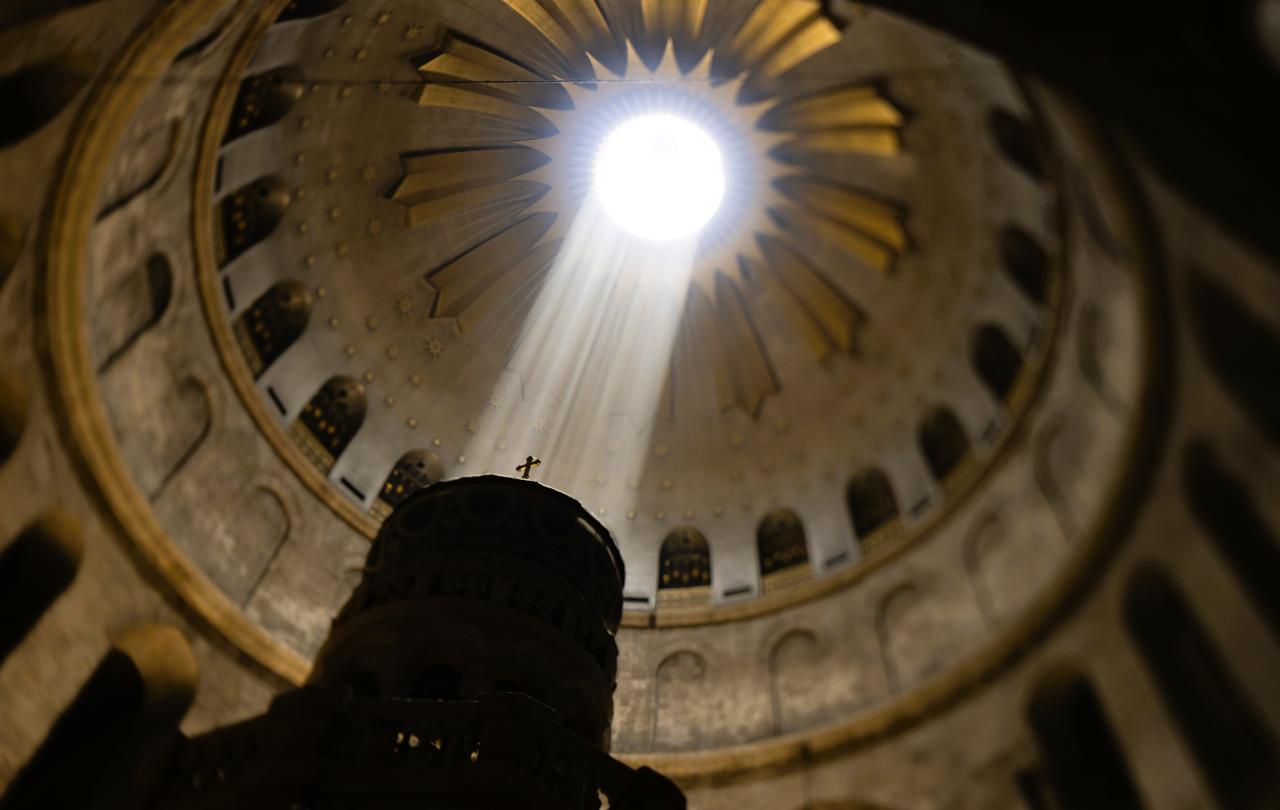
This film, this pilgrimage, this story begins in Jerusalem in the rotunda of the Church of the Holy Sepulchre with its Aedicule, a small chapel, containing the tomb from which Jesus rose.
Jesus' resurrection was revolutionary because it is the first fruits of a wider resurrection into a new heaven and a new earth, the new Jerusalem, where all that is harmful on earth is transformed into eternal glory and beauty.
The Church of the Holy Sepulchre holds that vision within its walls, a vision that was then transported throughout the world through pilgrimage and creatively replicated in other locations so that all who entered their local church or cathedral would be transported through art and architecture to the New Jerusalem.
US philanthropist and author Roberta Ahmanson thinks that American Protestants, in particular, have neglected this story because of the Reformation's preference for word over image. As a result, in 2022, she gathered an eclectic group of Christian college presidents, church pastors, and Christian creatives taking them on a pilgrimage from Jerusalem to London via Italy and Aachen while filming their responses to the visual history of the New Jerusalem as found in the churches they visit. In their two-week journey, the group cover almost 2,000 years of church art and architecture.
Ahmanson explains that this search for the reality of the Kingdom of God as it is to be realised in the New Jerusalem at the end of time did not mean that pilgrims were to abandon the world. On the contrary, she says, "their job was to serve this world to make it more like the heavenly home where their ultimate citizenship lay." That remains the aim of this art and architecture as:
“By studying the nature of that promised place, as artists and architects and writers of the past have sought to express it, we are schooled to live lives of wholeness and beauty right here on earth. The longing for beauty is ultimately a longing to be Home, to be in the place where we are whole.”
The beauty of the churches visited on this pilgrimage provided a vision of the New Jerusalem to those who entered in order that they took that vision into their everyday lives when they left. Along the way, the pilgrims on this trip learnt how artists, architects and theologians worked in parallel for many centuries – from Saint Augustine’s vision of a New Jerusalem to Dante’s admonitions about the Last Judgment.
The film combines scenes of beautiful interiors with explanations of their significance from Ahmanson and others, plus it shows the reactions of various of the pilgrims as they allow their sense of wonder and understanding of Church history to be expanded. David and Joy Bailey, founders of Arrabon which cultivates Christian communities to pursue healing and reconciliation in a racially divided world, are two of those to have spoken about the impact the trip had on the group of pilgrims.
Joy said: “Everybody was very literate coming from these strong traditions of faith being either oral or written but to see it so visually impacting, it was breaking us all open and trying to find language for that took the entire trip.” David suggested that: “What the trip was helping you to see was this deeper rootedness, this long tradition that, I think, could actually be very helpful for us today because some of the things that were there were the understanding of humanity as plain on the outside and beauty on the inside, the glory that comes with the inward journey that reflects on Heaven as it is on Earth.”
Re-enacting, revisiting and reinhabiting Christ's journey to the cross and the meaning of his resurrection remains central to Christian experience
As we travel further from Jerusalem in the film, we are surprised to find that the template of the Holy Sepulchre continues to inspire and shape the experience of pilgrims. Ahmanson explains that: “In churches across the old Roman Empire, from Africa and Palestine to the furthest reaches of Britain, liturgy was created to tell the story and to bring the spaces alive in the telling. Pilgrimages to Jerusalem and later to Rome and then to the tomb of Saint James in Spain became a kind of geographic liturgy. When the trip became too long or … too dangerous, believers found alternative destinations. Across the continent, from Magdeburg in Germany and Constance in Switzerland, to Bologna and Pisa in Italy and London and Cambridge in England, round churches or smaller models replicating the Church of the Holy Sepulchre became pilgrim destinations.”
Re-enacting, revisiting and reinhabiting Christ's journey to the cross and the meaning of his resurrection remains central to Christian experience, particularly during Lent and Holy Week. Walking labyrinths, Palm Sunday processions and Passion dramas, praying the Stations of the Cross, washing feet on Maundy Thursday, sharing a Passover meal, the Good Friday three-hour devotional, and the Dawn Eucharist on Easter Day are among the many ways Christians continue to follow in the footsteps of Jesus while remaining where they are during this most special season.
Many of these practices provide the opportunity to go on pilgrimage while remaining at home. Just as with images of the New Jerusalem brought from Jerusalem to the churches of Europe, so with, for example, the practice of praying the Stations of the Cross which originated in medieval Europe when pilgrims were unable to visit the Holy Land, so instead “visited” the Holy places through prayer.
The film, and other creative off-shoots including exhibitions of photographs from the pilgrimage taken by Kieran Dodds and performances by spoken word poet Street Hymns (one of the pilgrims), with his fellow poets Hanna Watson, Jasmine Sims, and Lo Alaman, in response to images of the New Jerusalem, provide viewers with a similar opportunity to experience, reflect and pray. The aim of all these initiatives is, as Ahmanson explains, what has always been the aim; “to serve this world to make it more like the heavenly home” where our ultimate citizenship lies, and to do so by “creating beauty in buildings and art and music and serving the suffering and those in all kinds of need”.
Explore more
Celebrate our 2nd birthday!
Since March 2023, our readers have enjoyed over 1,000 articles. All for free. This is made possible through the generosity of our amazing community of supporters.
If you’re enjoying Seen & Unseen, would you consider making a gift towards our work?
Do so by joining Behind The Seen. Alongside other benefits, you’ll receive an extra fortnightly email from me sharing my reading and reflections on the ideas that are shaping our times.
Graham Tomlin
Editor-in-Chief





